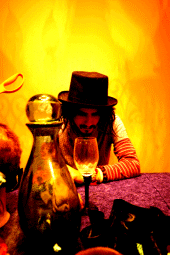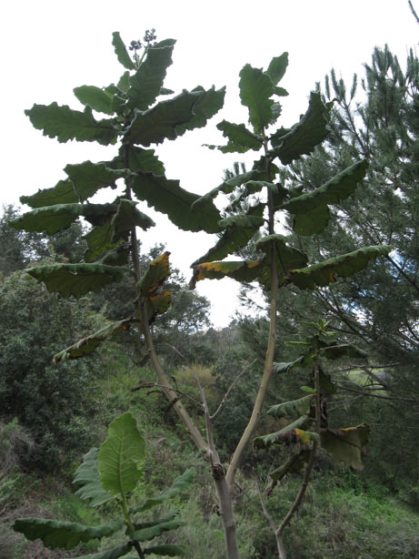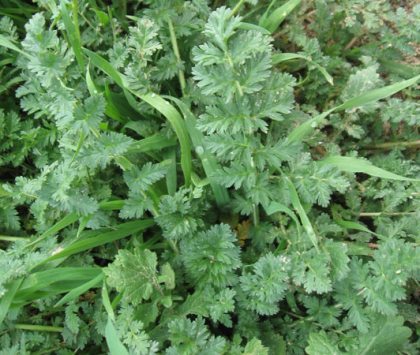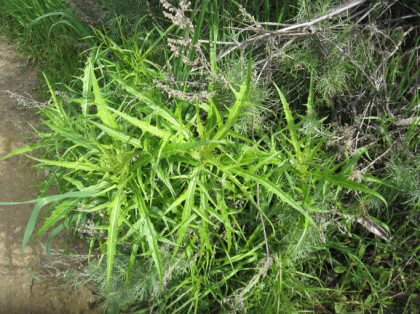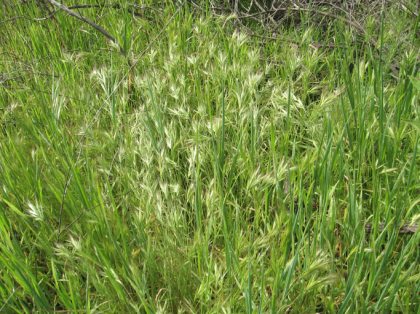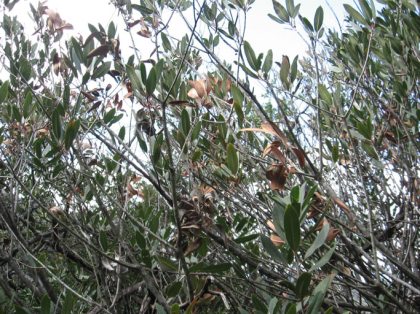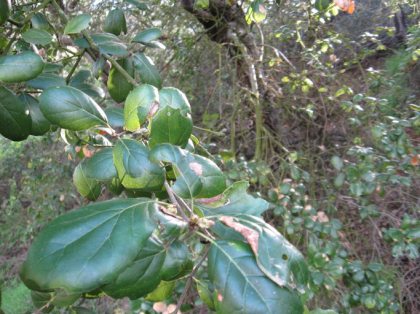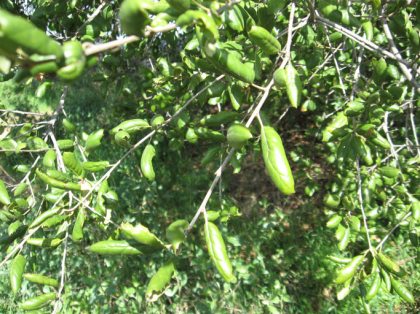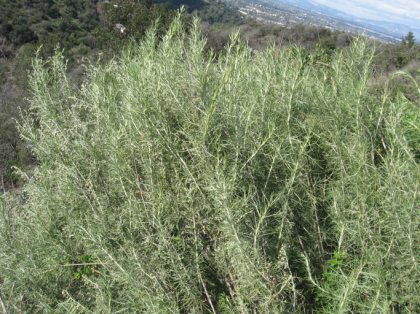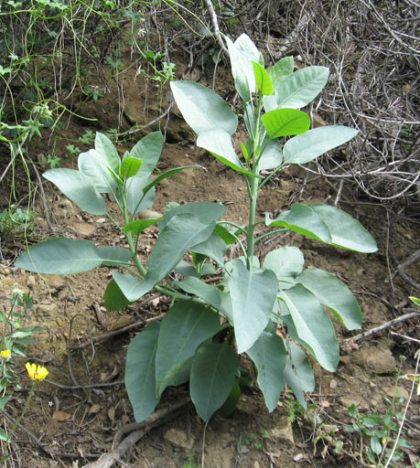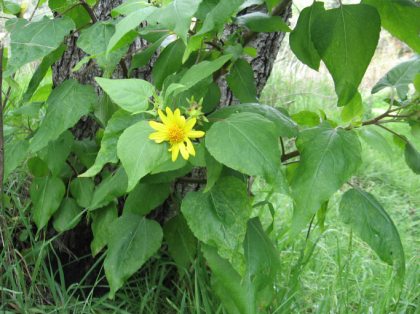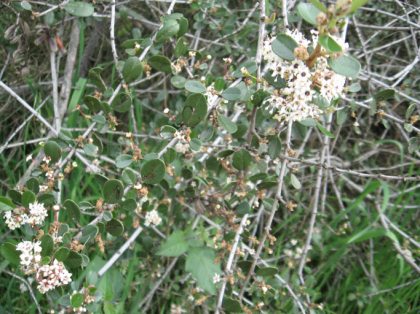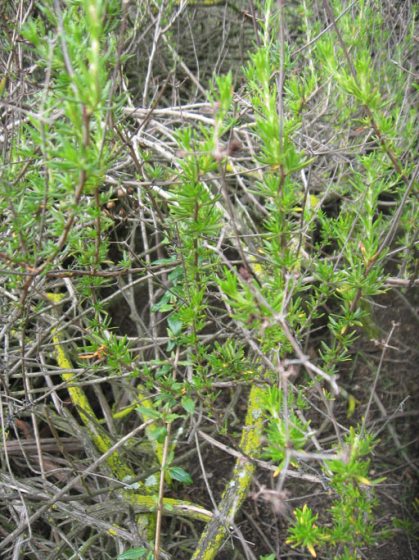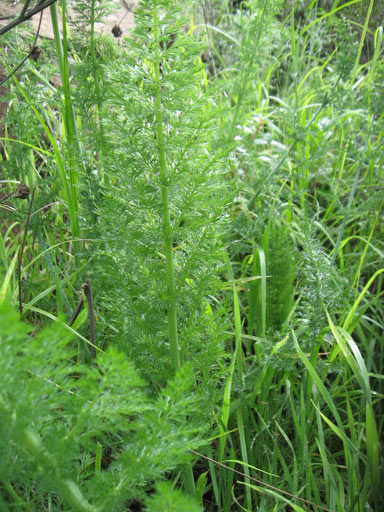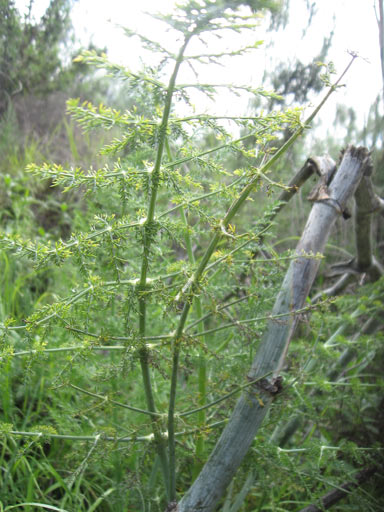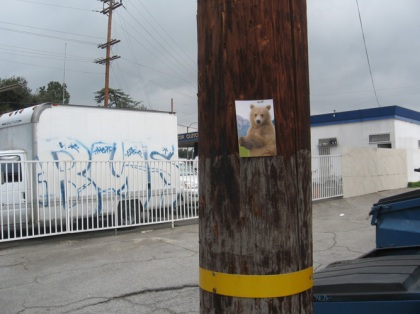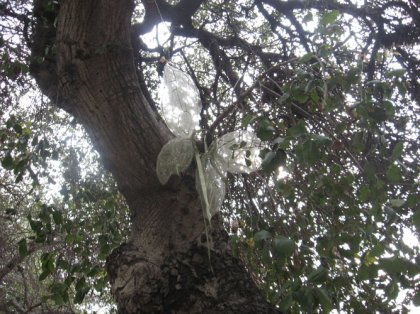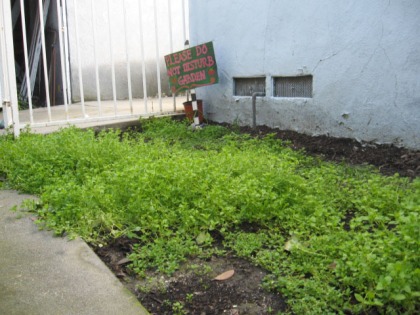Filed under: Photos, Plant documentation | Tags: adenostoma fasciculatum, artemisia californica, black sage, buck brush shrub, california native plants, canyon sunflower, castor bean plant, ceanothus cuneatus, cecilia garcia, chamise, coastal sagebrush, flora, foeniculum vulgare, fuchsia flowered gooseberry, herbal cigarettes, hiking, horehound, local trails, los angeles trails, marah macrocarpus, marrubium vulgare, milk thistle, mystery plants, nancy hoover pohl overlook, nicotiana glauca, oaks, plant identification, plant pictures, rhus ovata, ribes speciosum, ricinus communis, salvia mellifera, santa monica mountains, silybum marianum, sugar bush, sweet fennel, tree tobacco, u-vanu trail, venegasia carpesioides, wild cucumber
In the Santa Monica Mountains off Mulholland Drive just west of Laurel Canyon is the Nancy Hoover Pohl Overlook, one of my favorite places to hike. There are a couple different trails one can take from the overlook, one which connects to multiple other trail options in the area and one that is less than a mile long and dead-ends behind a neighborhood in the hills. The latter I believe is called the U-Vanu trail, but it’s hard to find an authoritative source for that–maps I’ve seen aren’t perfectly clear & the most confident sounding reference to it is from LAist here. Though the U-Vanu trail is short, it has a pretty diverse repertoire of flora to display, and I took all the following pictures in this lengthy post on the afternoon of February 20th, 2010. If you happen to download or post them anywhere, please credit to “D. Bene Tleilax” and a link back here would be nice. Thanks!
+ + + + + + + + + + + + + +
Sometimes I’m not very good at distinguishing between species of a particular type of plant; I am also still very much an amateur with identification in general. If you see that I’ve made any errors please do me a favor and post your corrections!
First up are the mystery plants. Plants can be pretty difficult to search for when you don’t know their names and I haven’t had any success with these ones. Any tips would be appreciated.
This one has a somewhat similar growth habit to the Fuchsia Flowered Gooseberry (seen below) in the way its stalks protrude around its territory.
///////////////////
One of the most singularly prominent plants along the trail, there is only one of these creatures and it has staked out its claim on the steep hillside that descends into the canyon below. I am really curious about this particular plant. The leaves are very large and seem fuzzy, though I haven’t touched them since they are growing out the side of a cliff.
//////////////////
These leaves look really yummie to me, but I wouldn’t dare eat them without knowing what they are.
//////////////////
What is it?
//////////////////
The leaves look different in both of these pictures but I’m pretty sure they’re the same species of plant, the bottom just looks younger and less jumbled to me. In the bottom photo the leaves are shaped like hearts, much like sunflowers. Note the interesting and fairly large green berries in the top photo, which also sorta look like they could be flower buds except for how large some of them are.
//////////////////
These spiky leaves have a really nice light green color. They look really cool and I can’t wait to find out what this is.
//////////////////
Another mysterious young spiny herb I’m quite fond of.
//////////////////
These seem pretty clearly in the Asteraceae family but I’m not very familiar with flower species.
//////////////////
I’m not up on my grasses either…
//////////////////
These leaves look like seashells to me. The lighter green ones in the middle were actually that color even though it looks like it’s a lighting thing.
//////////////////
The way the leaves all reach to the sky makes me think this is toyon (heteromeles arbutifolia), though this is a relatively new species to me and I could be mistaken.
//////////////////
This seems like some sort of oak, though I’m not sure.
//////////////////
I think this might be a coast live oak (quercus agrifolia) based on the way the leaves all curve down, but it’s really hard for me to distinguish oaks right now since I haven’t studied them much and many of them seem quite similar.
//////////////////
This appears to be a fresh patch of young milk thistle (silybum marianum) which hasn’t yet put up any stalks.
//////////////////
At first I thought this was laurel sumac (malosma laurina) since it has leaves very obviously shaped like taco shells. Then when flipping through a library copy of Flowering Plants of the Santa Monica Mountains I happened across sugar bush (rhus ovata) and saw that the flower style is significantly different from laurel sumac, and indeed that is actually what I had found.
//////////////////
The top is black sage (salvia mellifera), the bottom coastal sagebrush (artemisia californica), both ubiquitous shrubs in this area. Before I knew what sagebrush was I called it the “bubblegum plant” because of its strong gum-like scent. It’s one of my favorites. It’s also one of the plants I like to smoke when I roll herbal cigarettes from plants I harvest myself (mixed with mugwort, which can also be found along this trail though I didn’t take any pictures of it).
//////////////////
Speaking of smoking, this is tree tobacco (nicotiana glauca), the bottom being a handsome youngster. I’ve never actually tried smoking this even though I would like to, because I can’t find enough reliable information on it being safe to do so. I’ve seen references to it being smoked normally, but also seen references to it making your head feel like it’s going to explode. It’s tempting, but the fact that it has definitely killed people who ingested it in other ways gives me pause.
//////////////////
The castor bean plant (ricinus communis) knows a bit about killing people, as its seeds are highly poisonous. As the genus name suggests, it contains the toxin known as “ricin”. It kinda looks like a wicked plant, doesn’t it? I think it looks really cool, and before I knew what it was it always stood out to me since it looks so strange and unique.
//////////////////
Another deadly but neat looking plant, the wild cucumber (marah macrocarpus) has large spiky green seed pods containing seeds that were once used by the Chumash in a tea to peacefully euthanize those who wouldn’t be able to recover from some sort of accident that had befallen them, according to medicine woman Cecilia Garcia. The bottom picture displays a blurry and curly tendril grasping onto the branch of another plant, an easy way to spot this common vine.
//////////////////
I’m usually more into weeds, herbs, and other plants which have definite practical usages than wildflowers, but ultimately I’m interested in learning all of the plants which grow around me. The canyon sunflower (venegasia carpesioides) is a pretty looking native and I love its large, healthy looking leaves.
//////////////////
Another new one for me, which I believe is the buck brush shrub (ceanothus cuneatus). It has taken me a while to see the differences between all the shrubs of the chaparral plant community; at first glance they all appear somewhat similar and non-distinct. Once I really started paying attention and focusing on their individual traits, they each became much more distinguished.
//////////////////
This is chamise (adenostoma fasciculatum).
//////////////////
The magnificent fuchsia flowered gooseberry (ribes speciosum). I love the way the stalks all protrude from the center, it looks very spidery and tentacled in a way. This really is a beautiful plant. The hanging flowers, dark, glossy leaves, and bright red or pink thorns make it quite unique and one of my favorite discoveries. Not to mention the berries that develop are edible.
//////////////////
Horehound (marrubium vulgare). There is lots of this weed along the trail. I like it.
//////////////////
Finally we have sweet fennel (foeniculum vulgare), another common weed of the area. A long time ago I ordered fennel seeds in bulk for culinary usage, and it was a while before I discovered that they came from this plant (or one of its relatives). You can break off stalks of this plant and chew them right then and there, and it will fill your mouth with a licorice taste. Careful though, as it is said to look very similar to poison hemlock, which will fill your mouth with a death taste right then and there, or at least within about 15 minutes of horrid suffering. I’ve seen poison hemlock many times and to me it looks pretty different, but I suppose similar enough for everyone to always warn about it when talking about fennel. By the way, that dead stalk in the bottom picture is from a past generation of the plant–they can get pretty thick and tall.
//////////////////
I hope this collection of plants I’ve spotted along the trail is useful for anyone who may be trying to identify plants they’ve seen, though of course it is by no means comprehensive and I am no expert. The reason I made this post is mainly because nobody else has done something like this for that particular trail or portion of the mountains. I wish somebody had, because it makes learning about the plants you see on hikes much easier if you can look up pictures someone has taken from that exact location and match them to what you saw when you were there. Perhaps I will do more of this in the future.
Filed under: Letters, Politrix, Philosophical Musings | Tags: informed voters, ignorant voters, third parties, two-party system, informed public, california league of conservation voters, CLCV, green party, libertarian party, hiding information, logic, solutions, multiple perspectives, the american public, warner chabot, open discussions, republicans, democrats, progress, exclusivity, california elections, laura wells
In general, I value open discussion and the consideration of multiple perspectives when searching for solutions to particular issues. I feel that weighing what everyone has to say is a crucial process in formulating a stance on something, and whenever I neglect to do this I end up wishing that I had been more thorough. This is why it is very important to not limit our sources for information to only a few channels–if we do we tend to absorb the bias inherent in them. Naturally, it can be assumed that just about everything is biased at least to some extent, making it our duty to analyze multiple perspectives if we intend to have a logical and objective opinion. We must listen to as many sides of the story as possible.
When it comes to politics this multi-sided approach to issues is of the highest importance, because both public policy and public edification (not to mention the state of the world) is at stake. Essentially, each political party represents a perspective on any given issue, and as a society, America currently seems to believe that out of all of them only two are important–those of the Republican and Democrat parties (and it’s arguable those perspectives are in many instances quite similar in practice). There are obviously more ways of thinking about things than represented by just these two views, and other approaches are just as important to be aware of when trying to figure out what we should be collectively doing in the world of politics. Though there are people who exert the extensive effort required to educate themselves on an individual basis, as a whole Americans are not hearing all sides of the story and are thus making intrinsically uneducated decisions about who should be running things and how.
The blame for this falls primarily upon the media and the political establishment represented by the big two parties (the “Titanic” parties), because these powerful organizations are, of course, concerned more with using their power to push their own viewpoints and achieve their own goals rather than letting others share the spotlight for the good of society. It’s an unfortunate reality that the establishment does not share my affinity for open discussion about a topic regardless of party affiliation, and that its agenda rarely seems to involve solving a problem effectively. The two-party system has a stranglehold on American politics, and it actively attempts to prevent the public from hearing critical perspectives that are necessary for understanding issues. Third parties (“independent” parties) such as the Green Party and Libertarian Party represent these wrongfully suppressed perspectives on issues, and when they are consistently excluded from the discussion, everybody loses.
I want to be very clear–I’m not talking about independent parties winning elections. I don’t necessarily think that’s an absolute requirement for improving our society, though certainly it would speed things up a bit in many cases and I’m quite supportive of it. For my purposes here it doesn’t matter who actually wins, but what they’re saying needs to be included in the debate–even if the Titanic parties keep winning, more stimulation and competition is absolutely necessary to keep them in line. By introducing important points into the arena, all candidates who are participating can still influence the platform and the expectations of the winner. I’ve seen this exact thing at work in local non-partisan elections. Even establishment candidates will adopt something they otherwise wouldn’t if they were faced with a wall of people who demanded it. People get smarter when they consider things from more angles–for example, they might take one thing a Green is saying and start asking all Democrats to adopt it because it makes sense. But if it’s never shown to them they may never think to take that step, and we collectively fail to progress.
Voters’ final choices should be made once they’ve incorporated information from every side of what’s going on, otherwise their decisions will be flawed*. When media outlets, organizations, Republicans, and Democrats try to keep independent party philosophies away from the American public, they are purposefully trying to create a herd of ignorant voters who they can easily take advantage of. They are giving a presentation that is far from comprehensive under the guise that they hold the only plausible options. When they pretend that independent parties don’t exist it should arouse suspicion about their true motives. Why do they want to hide information from the public eye? I think it’s generally safe to assume that when one group suppresses the voice of another group, they have something to lose should the other group’s message be publicized. I tend to think it’s because they are scared that people will recognize the faulty logic that’s been pushed on them once fresh perspectives are floating around. And people might actually do something about it, like evict the status quo.
Some may object that it is independent parties’ own fault that they do not receive coverage, claiming that they are not “getting themselves out there” enough, or that they are not presenting “viable” enough candidates with enough pre-existing public support to justify their inclusion in debates or articles. Independent parties actually try very hard to be included and are consistently blocked from the most far-reaching channels. The doors are not exactly standing open to anyone who comes, and anyone who claims they are is simply inexperienced or has other motives. And as regards the latter objection, it is fundamental that the logic of any given argument should be weighed for its own merits, regardless of how popular the person saying it is at the time–a lesson that frequently seems to be lost on those who consistently support philosophically inferior politicians simply because they come from a more established organization. In addition, I think the label of “viable” as used today to refer to candidates is purely a result of our current election system. If certain election reforms were enacted–such as public financing and instant runoff voting to name a couple–then there would be more “viable” candidates running because the system wouldn’t be so frontloaded towards Titanic candidates from the beginning.
In any case, these objections are beside the point. Ultimately it seems to me that the media should itself be at least to some extent institutionally responsible for including candidates who have qualified for the ballot in debates and public forums, regardless of how much popular support they currently have when compared to the Titanic parties. As the primary way that most people receive information, it is the media’s duty to report on things relating to the public interest, and an inclusive approach to all sides of the pinnacle of our supposed democracy–elections–would be among the highest ways of serving that interest. It’s not just a fair way of operating a democracy, it’s simply more intelligent and beneficial to society for all the reasons I’ve discussed here. We should therefore demand that independent parties be regularly included and each strive to pay more attention to them, instead of passively allowing ourselves and the rest of our communities to be strategically manipulated through the censorship of alternative viewpoints.
+++++++++++++++++++++++++++++++++++++++++++++++++++++++++++
(* Voters’ decisions are also flawed when they vote for the “lesser of two evils” instead of what is actually the best choice. Doing so is adopting a loser mentality that perpetuates an inferior government and corrupts the very purpose of democratic voting in the first place, creating instead an indirect and crippled version of democracy based on a fear to risk expressing our true desires. I believe we should instead be authentic and vote for what we feel is best regardless of whether or not we think it will “win”. I find it a far more potent statement than voting for something I know is worse and don’t actually support. It’s a choice we’re given and I personally wouldn’t want to be on record saying I want something that I really don’t. Additionally, an efficient and totally necessary election reform called Instant Runoff Voting completely solves the “lesser evil” problem in the current voting system. Look it up!)
+++++++++++++++++++++++++++++++++++++++++++++++++++++++++++
So because I believe that philosophy should lead to action, I wrote to Warner Chabot–head of the California League of Conservation Voters, a prominent environmental organization. The CLCV created a website for the 2010 California gubernatorial election called “GreenGov2010” and didn’t even deign to mention that there is a Green Party candidate in the race, while shamelessly using what obviously sounds like a Green Party website title. I find it absurd that an environmental organization would refuse to allow the Greens into the room to talk about being green, and plain deceptive to not even acknowledge that they exist. It is abundantly clear that something is fundamentally wrong when such a contradiction is presented without saying a single word, especially when they are well aware of what they’re doing. Ultimately, the CLCV damages its own mission when it ignores what the Green Party has to say about the issues.
I am writing to express my disappointment with the GreenGov2010.org site and its failure to include the Green Party candidate Laura Wells. I can’t help but feel like you are playing party politics again. The one thing that I’ve never liked about the CLCV is that one of the unstated “conservation” goals it seems to have is to maintain the status quo of the two party system and block valuable third party candidates from participating.
If we are to truly progress, people need to be aware of what everybody is saying about the issues. I don’t understand why it seems like you’re so determined to keep your thought process directly inside the box when it comes to this type of thing. The Green Party brings valuable, important insight to a wide variety of environmental issues, and can help to stimulate collective thought that will quicken our arrival at beneficial solutions. Why line up with everyone else who thinks that Republicans or Democrats are the only people who should be allowed to have a voice in discussing important issues?
Your latest decision to exclude the Green Party and Laura Wells lowers your credibility and that of the organization you direct. When an environmental organization stonewalls a political party that has been concerned with such issues for decades, I can’t help but feel that you’re far too biased to be trusted for real objectivity. While the work you do is good, you are unfortunately stunting the progress of the very things you fight for by refusing to at least allow them into the discussion.
Sincerely,
D. Bene Tleilax
Filed under: Letters | Tags: cereal, complaint letters, dangerous ingredients, food additives, food companies, malt-o-meal, partially hydrogenated oils, trans fats
I’ve written many complaint letters to food companies about the ingredients they put in their products, and one of the most common problems is the use of partially hydrogenated oils, also known as “trans-fats”. I recently wrote to Malt-o-Meal, a large cereal manufacturer:
Hello, I would like to express my concern that your company still finds it acceptable to utilize hydrogenated oils in your cereals. As many people are aware these days, the hydrogenation of oils has a very negative effect upon those who consume it, and there is a significant body of research which supports this. It bothers me that a company like yours which appears to be concerned about environmental impact and being a good corporate citizen finds nothing wrong with regularly using ingredients proven to be dangerous. I implore you to take the evolutionary step that many other cereal producers have, and cease this practice. Until you do, I cannot purchase your products.
They responded, saying:
We use many different ingredients to achieve specific characteristics (flavor, aroma, texture, etc.) in our finished cereals. Unfortunately, not all of these ingredients work for each consumer’s diet.
Comments like yours regarding our products are carefully reviewed to keep us informed of consumer opinions and current issues. We understand your concern about hydrogenated oils and your feedback is being shared with our product managers.
Hydrogenation cannot work for any person’s diet, so I sent this reply:
I appreciate your quick response. In light of your reference to diet, I’d just like to further clarify that this ingredient is not like an allergen, where some can consume it and be fine while others must avoid it. Partial (and full) hydrogenation damages every human system that allows it access, and it is for this reason I hope you will remove it from your otherwise quality product.
Filed under: Narratives | Tags: abandoned houses, adventures, cleaning up other people's trash, diary entries, exploration, finding things, foraging, herbs, hiking, local trails, nature, nopales, opuntia, recycling, wandering around, Wild Foods
May 21st, 2009:
Two sunny days ago, my companion and I embarked upon our weekly ritual of traversing the various trails of our local mountain wilderness. We arrived at a location previously unexplored by ourselves, and of the few possible paths accessible to foot-travel, we decided to take the westernmost trail. The entrance to this trail lies subtly amongst the scrub brush behind a half-circle of stone which serves as a bench for those who ascended to this point merely to look out into the canyon, a view which is admittedly quite fine. Because the trailhead could be easily overlooked by most, it in fact stood out to me as one which ought to be explored with immediate haste.
The trail followed a rather sharp decline down a northern facing slope. After perhaps a mite more than 5 minutes of steady travel, the path flattened out for merely a couple of yards, largely beneath accommodating trees with horizontal branches perfect for resting upon for a spell if one were weary on his way back up. As indicated by the ancient, fading black spray paint which decorated nearly all of the trees’ surface area with now indecipherable text and the surrounding multitude of much younger bottles and cans once filled with cheap American beer, the spot had indeed been used as an out-of-the-way respite. One traveler had even left a zippable sweatshirt behind, perhaps as a gift to the tree in exchange for its temporary shelter.
At this point, my companion and I decided that the road to the canyon bottom was too steep to further descend without walking sticks. Using a black plastic bag from a liquor store conveniently left behind, we proceeded instead to gather all of the aluminum cans, as I am in the consistent habit of doing wherever I happen across significant quantities of them. Aluminum is one of my most favored metals, from a purely practical perspective. Its utility value is high, and when converted into appropriate forms of energy–a process executed with fair simplicity–it propels both my vehicle and myself with the fuel it provides.
After depositing our unexpected bounty of metal into the trunk of my motor carriage, we proceeded down the easternmost trail. Following this trail, we walked upon a path which was on one side an often precipitous drop to the canyon floor, and on the other a hill raising itself at various grades. Throughout the trail was a wide variety of herbaceous growth, most of which are common and considered weeds. Many of them I could not yet identify, having still much to learn in my studies, but I will provide a small list of those whose names I know: sweet fennel, milk thistle, mugwort, blessed thistle, sagebrush, horehound, tree tobacco, and castor oil plants.
The trail ended after less than a mile near a group of unoccupied houses, mostly obscured from view by the vine-covered growth on the close hillside. A shaded staircase made of half meter long dirt steps reinforced by wooden blocks steeply ascended into a backyard which featured a swimming pool completely greened by algae. We descended stairs on the opposite side of the pool and walked around to the front of the house which brought the others into view. A cursory glance noted that two had suffered severe structural damage, perhaps as the result of a previous earthquake or natural erosion. The two with damage were quite easily accessible, with no efforts made whatsoever to block entrance to their interiors. The more elevated of the two, however, looked as though it would be a significant physical risk to wander through. We therefore entered the less damaged one and began to walk through its rooms, examining the remains.
Magazines were strewn about each room, popular ones dealing with very surface-level fashion trends and sex advice. Drawers remained, empty and without dressers to plug into. In the kitchen, vines had covered the windows and let only a thin and greenly tinted light into the room–a very attractive effect which I would consider worthy of designing for on purpose. Many things had been left behind in the various cupboards and drawers. Among the objects we retrieved were an unused spool of white thread with needle attached, a tomato-shaped pincushion filled with pins, four cans of vegetarian-suitable baked beans, a new box of Earl Gray tea, a tin emblazoned with the British flag containing cigarette rolling papers, a ball of rope-like twine, and some fabric. There were more items worth taking, however we did not wish to burden ourselves too much for the hike back and so perhaps another visit shall be in order for the future.
Upon our return to my vehicle, I took a square of cardboard and a knife and, grasping with the cardboard in my left hand, proceeded to slice off one freshly tweening cladode from three different opuntia specimens in the area, distributing my harvest among them out of respect for their new growth. We then vacated the premises and retired to our abode. After despining and chopping the opuntia cladodes, called “nopales” in Mexican cuisine, I added them to a pot filled with the canned beans we had acquired from the deserted residence, wherein they served as a delicious and nutritious vegetable in this meal which was fully and freely provided to us by the day’s adventuring.
